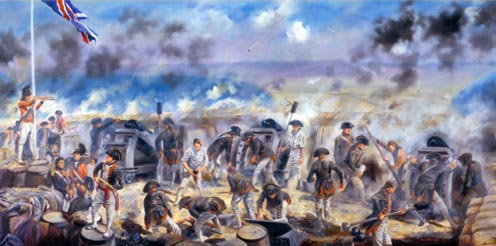| |
« Click on Picture to
Return » |
|
|
 |
|
Koehler Depressing Guns of the Royal Artillery
1782-83: The Great Siege of Gibraltar lasted from 24 June 1779 until 7 February 1783.
In replying to the Spanish bombardment, part of which came from floating batteries and ships, it was found that the British guns high on the Rock could not be depressed sufficiently to engage the enemy. An enterprising young subaltern, Lieutenant Koehler, made some trials and designed a wooden gun carriage which would allow the gun to be depressed to 42 degrees below the horizontal plane in order to fire downwards. There are models of these depressing guns, and Koehler's original drawings of both his invention, and scenes at various batteries, survive. John Drinkwater, who was present and wrote a history of the Great Siege, describes the first practice of this new depressing gun in 1782. Under the approving eyes of the Governor and senior officers it proved very successful and fired accurately down on to the Spanish batteries on the isthmus. The gun barrel was swivelled on the horizontal for ease of loading.
A gun battery in those days was heavily defended by gabions, fascines and sandbags, and this limits the view of the guns. In order to show a battery of depressing guns in action, as well as the panorama beyond, I have chosen to imagine the scene from a position looking down upon the battery from behind. We can see the enemy battering ships in the bay and the Spanish siege lines across the isthmus. Sometimes as many as twenty enemy shells could be seen in the air at the same time.
This painting was commissioned by 22 (Gibraltar 1779-83) Battery Royal Artillery.
Medium: Oil on Canvas
Printed image size(s): B2 only (58 x 38 cm)
Owner: 22 (Gibraltar 1779-83) Battery Royal Artillery
Price(s): £70
|
|
| |
|
|
|
|
|
|
|
|
|
|
|
|
|
|
|
|











